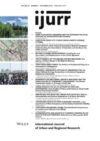This article seeks to conceptualize and value some of the quotidian geographies responsible for contemporary forms of urban change. The starting point for the argument is an attempt to account for recent urban change in the Palestinian city of Ramallah, particularly the proliferation of apartment buildings, using emerging work on verticality. It is argued that work on verticality focuses empirically on prominent cities and spaces of violent conflict, invokes the vertical as politically suspect and offers a theorization of space that is topographical in nature. Consequently, accounts of verticality have produced narratives that obscure topological spatial relations. This article seeks to make space for such topologies, which it is argued are crucial to producing urban and political life itself in many contexts. The concept of ordinary topologies is proposed as a means of attending to the complex and undervalued practices that are thought to be normal (but not static) and common within and across intensive or qualitative spatio‐temporal relations. This approach is fleshed out through a discussion of changing topographic–topological landscapes in Ramallah. In particular, it is argued that the increasingly verticalized landscape of the city, embodied in rapidly proliferating apartment buildings, must be understood in relation to frequent journeys to other places and changing family relations.
Details
Written by:
Christopher Harker
Digital Object Identifier (DOI)
10.1111/1468-2427.12094
About DOI
Read full article as PDF
Read full article as HTML
See the references for this article
